 Futuristic robots may be coming soon to an ocean near you. Sensorbots are spherical devices equipped with biogeochemical sensors, that promise to open a new chapter in the notoriously challenging exploration of earth’s largest ecosystem—the ocean. (Credit: Image courtesy of Arizona State University) ScienceDaily
Futuristic robots may be coming soon to an ocean near you. Sensorbots are spherical devices equipped with biogeochemical sensors, that promise to open a new chapter in the notoriously challenging exploration of earth’s largest ecosystem—the ocean. (Credit: Image courtesy of Arizona State University) ScienceDaily — Futuristic robots may be coming soon to an ocean near you. Sensorbots are spherical devices equipped with biogeochemical sensors, that promise to open a new chapter in the notoriously challenging exploration of earth's largest ecosystem -- the ocean.
Much of Meldrum's genomic research focuses on deep ocean environments and leverages her extensive technology development for human health and disease. In 2001, her group was awarded an $18 million grant for a National Institutes of Health Center of Excellence in Genomics Science, which led to the establishment of the Microscale Life Sciences Center (MLSC) -- currently headquartered at the Biodesign Institute in the Center for Biosignatures Discovery Automation. (The MLSC grant was subsequently renewed for an additional $18 million.)The devices are being designed and developed in the laboratory of Professor Deirdre Meldrum, ASU Senior Scientist and Director of the Center for Biosignatures Discovery Automation at Arizona State University's Biodesign Institute.
Meldrum's Center brings together researchers in electrical, mechanical, chemical, and bio- engineering, chemistry, computer science, materials science, laboratory medicine and microbiology as well as personnel from the Fred Hutchinson Cancer Research Center, University of Washington and Brandeis University. Together, they work on developing microscale devices to analyze cells and their DNA, RNA, and proteins to understand and eventually diagnose or prevent diseases such as cancer and inflammation.
To accomplish this, Meldrum and her colleagues develop microscale modules to measure multiple parameters in living cells in real time in order to correlate cellular events with genomic information. As Meldrum explains, the Sensorbot project significantly expands the scope of oceanographic investigations carried out by Biodesign's Center for Biosignatures Discovery Automation:
"We are leveraging our automation, sensors, biotechnology, and systems expertise to develop unique robots that can be deployed by the hundreds, travel in formation, and communicate together for exploration and discovery. The Sensorbots will enable continuous spatiotemporal monitoring of key elements in the ocean and the ability to respond to events such as underwater earthquakes and hydrothermal vents. Such research is essential for a more thorough understanding of the multiple systems in the oceans -- microbes and other sea life, geology, and chemicals."
Assistant Research Professors Cody Youngbull and Joseph Chao are both integral members of the Sensorbot team and have spent years developing the technology. Much of this creative tinkering has taken place in the labs at Biodesign, situated in landlocked Arizona. But in the summer of 2011, Youngbull took the Sensorbots to the deep ocean, aboard the Thomas G. Thompson, a global-class research vessel operated by the University of Washington, as part of UNOLS (University-National Oceanographic Laboratory System) and used as part of the National Science Foundation's Ocean Observatories Initiative.
The ambitious Sensorbot project is utilizing the National Science Foundation's Ocean Observatories Initiative -- in particular, the Regional Scale Nodes (RSN) project, led by Professor John Delaney of the University of Washington. This far-flung endeavor involves the construction of a cabled underwater observatory in the NE Pacific Ocean, off the coasts of Oregon, Washington, and British Columbia on the Juan de Fuca tectonic plate. This area is home to many dramatic undersea features, including volcanoes and hydrothermal vents -- wellsprings of unique life forms.
The cabled observatory provides high bandwidth and power for real-time oceanographic observations and experiments. These include the study of mineral concentrations, gas compositions, biological blooms, and detailed analyses of extremophiles -- organisms flourishing in environments usually considered inhospitable to life. The cabled observatory with high power and bandwidth provides the Sensorbots with the ability to recharge their batteries and download their data, allowing immediate transmission via the internet and making the information available to scientists and educators anywhere in the world.
The current Sensorbots are fist-sized transparent robotic orbs, which communicate via brilliant blue flashes of light. The spheres house electronics and batteries, while their surfaces have 3 sensors for measuring pH, temperature or oxygen. Sensorbots report surrounding environmental conditions to the inner electronics that convert the signal into flashes of light, providing a sort of visual Morse code.
A high-speed camera situated on the seafloor picks up the signals and stores them for later decoding aboard the ship. As sensorbot technology develops, these orbs may blanket large areas of the ocean and transmit information regularly to a central data hub. Ultimately, Sensorbots will be capable of operating in semi-autonomous robotic swarms, moving under remote control, in a 3D geometric formation through precisely controlled volumes of seawater.
Sensor swarms operating autonomously could function in complex, harsh, and remote environments. With appropriate microanalytical systems mounted on the Sensorbot platforms, these synthetic mariners could perform spatially and temporally indexed genomic analyses of microbial communities, as well as observing a broad variety of macro events.
As Youngbull explains, the Sensorbot technology has undergone several stages of development. "We've built 3 versions of Sensorbots over the years and now we're moving on to a fourth," he says. This latest iteration -- known as p3N -- will function independently and provide networking capabilities, allowing members of the swarm to communicate with each other. The optical signals transmitted by the Sensorbots will be linked, using so-called multi-hop networking technologies, not unlike those used for cell phone and other land-based wireless networks.
"Sensing webs are an exciting thing," Youngbull says, "because the scale of phenomena are vast in the oceans." Rather than delivering a very expensive robot to a single point in space and then serially moving it around, often missing dynamic phenomena, an array of inexpensive Sensorbots can cover a wide field, permitting real-time investigations of earthquakes, biological blooms, and other episodic phenomena.
"Networking will allow us to trail sensorbots like a string of pearls over great distances -- so we'll get all the benefits of optical communication speed and energy efficiency without the detriment of optical loss and attenuation in sea water," Youngbull says.
During the most recent research cruise, Youngbull helped position the Sensorbots on the seafloor, with the aid of ROPOS -- a Canadian remotely operated vehicle. The Sensorbots were deployed to a crushing depth of over 1500 meters in and around a hydrothermal vent field in the cauldera of an undersea volcano. Twenty Sensorbots were deployed over hundreds of square meters and monitored continuously for 3 days using a high speed underwater camera.
The new p3N sensorbots currently under construction will have inertial monitoring units, allowing them to sense when and where they have been moved. Eventually, the devices will have their own onboard propulsion systems, allowing them to be controlled independently from afar. The challenges of creating such systems are significant. Initially, sensorbots may be designed to automatically adjust their buoyancy to take advantage of the natural movements of ocean current.
The group will be continuing their Sensorbot experiments in a new undersea cabled environment belonging to the Monterey Bay Aquarium Research Institute (MBARI). While the team's focus will be on undersea microbial research, the concept of a multi-hop capable node, that functions to detect many different analytes in an inexpensive, compact format has other potential applications, including national security, epidemiology, and contaminant plume monitoring.
In addition to MBARI, the Center for Biosignatures Discovery Automation collaborates with other schools at ASU, including the School of Earth and Space Exploration and the Global Institute of Sustainability.
"Nobody brings it all together like we do, with the sensors, the embedded systems, the data transfer and communication," Youngbull says. Meldrum is very enthusiastic about the use of this technology for advancing science in previously inaccessible realms of the deep ocean: "Sensorbots will provide a continuous presence in the ocean over space and time, from nanometers to kilometers and nanoseconds to years, enabling us to discover and understand the complex biogeochemical systems of our oceans that play a key role in our quality of life."
Sea Beacons
In the laboratory, a Sensorbot flashes out its code. By means of these brilliant blue pulses of light, the spherical undersea robot relays information about its environment. The light code is captured by high-speed cameras, which record and transmit the data for later analysis.
Taking the plunge
An array of Sensorbots is escorted to the ocean floor by means of the Remotely Operated Platform for Ocean Science or ROPOS -- a Canadian submersible device.
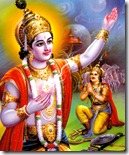 “The original source of knowledge is the Vedas. There are no branches of knowledge, either mundane or transcendental, which do not belong to the original text of the Vedas. They have simply been developed into different branches, They were originally rendered by great, respectable and learned professors.” (Shrila Prabhupada, Shrimad Bhagavatam, 1.4.23 Purport)
“The original source of knowledge is the Vedas. There are no branches of knowledge, either mundane or transcendental, which do not belong to the original text of the Vedas. They have simply been developed into different branches, They were originally rendered by great, respectable and learned professors.” (Shrila Prabhupada, Shrimad Bhagavatam, 1.4.23 Purport)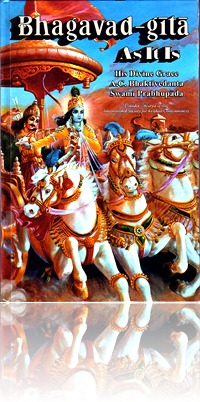 With respect to the Vedas, the authority is firmly established after following the foremost recommendations. The fear we may have of falling victim to a bogus system of religion is ameliorated by the stock of great leaders and pious men who have followed the original scriptures of India, whose most concise and complete treatise is known as the Bhagavad-gita. This sacred text starts off with an issue that every man must address at some point: death. Immediately, the speaker of the Gita, Shri Krishna, states that the soul is the essence of identity and that the body is temporary. The soul does not cease to exist after death nor did it come into existence at the time of birth. The soul is always there, regardless of whether we can see it or not.
With respect to the Vedas, the authority is firmly established after following the foremost recommendations. The fear we may have of falling victim to a bogus system of religion is ameliorated by the stock of great leaders and pious men who have followed the original scriptures of India, whose most concise and complete treatise is known as the Bhagavad-gita. This sacred text starts off with an issue that every man must address at some point: death. Immediately, the speaker of the Gita, Shri Krishna, states that the soul is the essence of identity and that the body is temporary. The soul does not cease to exist after death nor did it come into existence at the time of birth. The soul is always there, regardless of whether we can see it or not.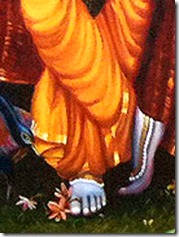 Based on the modes adopted, a living being develops a certain kind of faith. In the lower species, the faith relates strictly to sense pleasures. The animals don’t know anything beyond eating, sleeping, mating and defending because their bodies are made up almost entirely of the mode of ignorance. In the human form of body, there is variety in engagement. Though the original Veda, which was passed on by the same Shri Krishna at the beginning of time, was meant primarily for those in pure goodness, this doesn’t mean that other living beings are left out.
Based on the modes adopted, a living being develops a certain kind of faith. In the lower species, the faith relates strictly to sense pleasures. The animals don’t know anything beyond eating, sleeping, mating and defending because their bodies are made up almost entirely of the mode of ignorance. In the human form of body, there is variety in engagement. Though the original Veda, which was passed on by the same Shri Krishna at the beginning of time, was meant primarily for those in pure goodness, this doesn’t mean that other living beings are left out.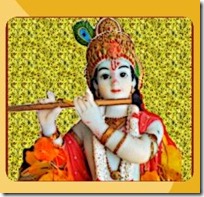 Isn’t saying that we come from Krishna a dogmatic principle? The fact that there is an entity superior to us has no bearing on sects or traditions. We already know that death is superior to us because it forces us to exit a body when we don’t want to. The irrepressible forces of nature also influence our behavior. If we were superior to nature we wouldn’t have to wait for the sun to come up in the morning or be forced to go to sleep at night. At the same time, we know that we are dominant over dull matter, as we can tell our body where to move and how to act.
Isn’t saying that we come from Krishna a dogmatic principle? The fact that there is an entity superior to us has no bearing on sects or traditions. We already know that death is superior to us because it forces us to exit a body when we don’t want to. The irrepressible forces of nature also influence our behavior. If we were superior to nature we wouldn’t have to wait for the sun to come up in the morning or be forced to go to sleep at night. At the same time, we know that we are dominant over dull matter, as we can tell our body where to move and how to act.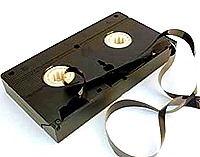 The same loss has occurred with the original set of information passed on by Krishna. Bhagavata-dharma is complete information because it helps the soul cope with a land where material nature has a dominating influence. With information on how to stop the influence of the senses, one can find the bliss that they are searching after. That being said, if one is given towards associating with one of the three modes of nature, they can grab ancillary information from the Vedas and use that to form their own system of maintenance. Hence you get different branches of knowledge.
The same loss has occurred with the original set of information passed on by Krishna. Bhagavata-dharma is complete information because it helps the soul cope with a land where material nature has a dominating influence. With information on how to stop the influence of the senses, one can find the bliss that they are searching after. That being said, if one is given towards associating with one of the three modes of nature, they can grab ancillary information from the Vedas and use that to form their own system of maintenance. Hence you get different branches of knowledge.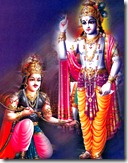 Whoever connects directly with Krishna and accepts all of His instructions will learn that the soul’s only business is to connect with God and that through that established yoga one can acquire the knowledge necessary for dealing with life’s other issues. Arjuna, the recipient of the Gita on that famous day on the battlefield of Kurukshetra, used the sublime wisdom imparted to him to fight on without attachment in a difficult war. But more importantly he retained that information so that he could stay connected with Krishna. He who has the reservoir of pleasure at the forefront of their consciousness automatically stays in contact with the original source of supreme wisdom and thus has no reason to fear not knowing which path to take in life.
Whoever connects directly with Krishna and accepts all of His instructions will learn that the soul’s only business is to connect with God and that through that established yoga one can acquire the knowledge necessary for dealing with life’s other issues. Arjuna, the recipient of the Gita on that famous day on the battlefield of Kurukshetra, used the sublime wisdom imparted to him to fight on without attachment in a difficult war. But more importantly he retained that information so that he could stay connected with Krishna. He who has the reservoir of pleasure at the forefront of their consciousness automatically stays in contact with the original source of supreme wisdom and thus has no reason to fear not knowing which path to take in life.







